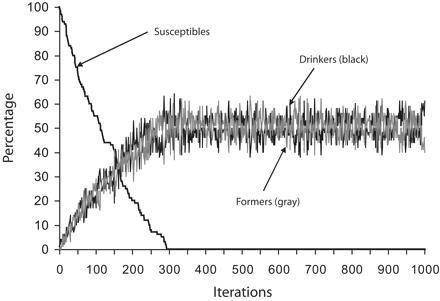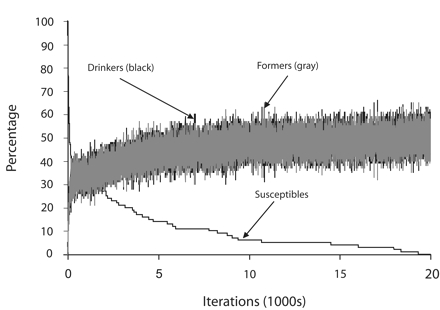Agent-based modeling—a tool employing multiple interacting agents to reveal emergent properties of systems that are not properties of the individual agents themselves1—has made significant in-roads into many social science disciplines,2 including public health. I congratulate Dennis Gorman and his colleagues on their effort to leverage these new tools to address specific public health concerns.3 However, given the novelty of agent-based modeling methodology and the resistance of those favoring traditional analytic methods,4 great care in application is necessary to increase the likelihood of acceptance. In this spirit, I offer a few concerns.
Most important, it is imperative to be clear about what agent-based models have to offer. Gorman et al. claim that their “models demonstrate that the basic dynamics underlying social influences on drinking behavior are shaped by contacts between drinkers and focused by characteristics of drinking environments.”3(p2055) The offered models demonstrate no such thing. At most, the models provide insight into the spatial dynamics of agents following programmed rules that respond stochastically to other agents in a highly stylized environment.5 Whether this teaches us about drinking behavior is an empirical question.4 Similarly, the “bar”3(p2058) is nothing more than a probabilistic sink that guarantees to attract the “drinkers” who in no way “chose to spend a greater portion of their time at this site”3(p2059) (emphasis added).
Ecological validity and simple face validity are also important concerns. In one instance, Gorman et al. sought to identify ecological components of drinking behavior that they suggest might be thought of as a college population that moves from a specific site with a given probability each day, operationalized as a random walk.3(p2056) However, each of these students will have his or her own sink in the form of an apartment or a dorm room that he or she should return to (at least on most days). Gorman et al.’s random-walk method quickly produces probabilistic homelessness.
Finally, precision is required in specifying models and reporting results. For example, a lattice can be bordered or unbordered (i.e., moving off the right side puts you on the left side) and conversion can be asynchronous or synchronous (all agents determine the new agent type before all agents convert together). I replicated a family of models with NetLogo 3.1.1 (Center for Connected Learning and Computer-Based Modeling, Evanston, Ill) to determine the likely characteristics of Gorman et al.’s models, with good results (Figure 1 ▶). (The “bar” model runs 20000 periods in approximately 40 seconds on a 1.6 Ghz Pentium processor; models are available from the author upon request.) This replication also helped me to sort out the mathematical error in Gorman et al.’s Figure 1 ▶3(p2056) (The ordinary proportion for conversion from susceptibles to drinkers,
FIGURE 1—

Replication of Gorman et al.’s3 primary model: P = .3; γ = .3; ρ = .3 on an unbordered lattice with synchronous conversions.

shown on the state diagram, rather than double this proportion as specified in the body text of the diagram is what I believe was intended.)
With this replicated model, I was also able to investigate concerns about the authors’ claim that with a “bar” on the lattice, susceptibles leveled “off at a constant nonzero value.”3(p2059) Analytically, this could not be the case. Indeed, the clustering of drinkers makes the conversion of a susceptible on a random walk a low-probability event, but the susceptibles do eventually go to zero (taking a mean of 10 822 periods over 50 runs), a characteristic missed because of incorrect assumptions of scale (Figure 2 ▶).
FIGURE 2—

Replication of Gorman et al.’s3 “bar” model: P = .3; γ = .3; ρ = .3.
Note. Drinkers probability of moving toward bar = 0.5 and probability of moving away from bar = 0.1.
For agent-based modeling to meet its promise, practitioners should resist the temptation to overstate the implications of model outcomes, carefully design agent-based models with an eye toward ecological validity, and provide precise specifications and results based on families of models subjected to repeated tests.
Acknowledgments
G. T. Jones’s research was funded, in part, by the William and Flora Hewlett Foundation.
References
- 1.Flake GW. The Computational Beauty of Nature. Cambridge, Mass: MIT Press, 1998.
- 2.Bankes SC. Agent-based modeling: a revolution? Proc Natl Acad Sci U S A. 2002;99(suppl 3): 7199–7200. [DOI] [PMC free article] [PubMed] [Google Scholar]
- 3.Gorman DM, Mezic J, Mezic I, Gruenewald PJ. Agent-based modeling of drinking behavior: a preliminary model and potential applications to theory and practice. Am J Public Health. 2006;96: 2055–2060. [DOI] [PMC free article] [PubMed] [Google Scholar]
- 4.de Marchi S. Computational and Mathematical Modeling in the Social Sciences. New York, NY: Cambridge University Press; 2005.
- 5.Bonabeau E. Agent-based modeling: methods and techniques for simulating human systems. Proc Natl Acad Sci U S A. 2002;99(suppl 3):7280–7287. [DOI] [PMC free article] [PubMed] [Google Scholar]
- 6.Lempert R. Agent-based modeling as organizational and public policy simulators. Proc Natl Acad Sci U S A. 2002;99(suppl 3):7195–7196. [DOI] [PMC free article] [PubMed] [Google Scholar]


